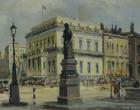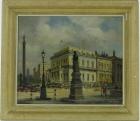"MAX HOFLER"
The view is taken from Waterloo Place with the statue of Florence Nightingale in the foreground and the Prince Frederick Duke of York Column beyond.
The Athenaeum is a private members' club in London, founded in 1824. It was originally a gentlemen's club but in 2002 the club's members voted to admit lady members. It has had many well known people as members. The distinctive clubhouse (located at 107 Pall Mall at the corner of Waterloo Place) was designed by Decimus Burton in the Neoclassical style with a Doric portico, above which is a statue of the classical goddess of wisdom, Athena. The bas-relief frieze is a copy of the frieze round the Parthenon in Athens. The club's facilities include an extensive library, a dining room known as the Coffee Room, a Morning Room, a Drawing Room on the first floor, a newly restored Smoking Room, where smoking is not permitted, and a suite of bedrooms.
John Wilson Croker, Sir Thomas Lawrence, and some friends founded the club in 1824 for individuals known for scientific, literary or artistic accomplishments as well as patrons of these endeavours. Sir Thomas Lawrence designed the club seal: a head of Athena inside an oval surrounded by the legend "ATHENÆUM CLUB·PALL MALL".
The club house was designed in Neoclassical taste by Decimus Burton. The main entrance and the front of the house on Waterloo Place has a Doric portico with paired columns. There is a continuous balustrade on the piano nobile, the main floor above the ground floor, with an outstanding but costly frieze copied from the Parthenon above. A statue of Pallas Athene by Edward Hodges Baily stands above the porch. The original design was for two storeys; the third and fourth were added later. Croker was much involved in the foundation of the club and the building of the clubhouse, resisting pressure from some members (in those pre-refrigeration days) that an ice-house be part of the scheme; hence the rhyme: I'm John Wilson Croker, I do as I please. Instead of an Ice-House I give you a... Frieze!
For many years The Athenaeum Club was widely seen to represent the peak of London's clubland for the public intellectual. Most members of the Athenaeum were men of inherited wealth and status, but, under Rule II, the club additionally admitted men "... of distinguished eminence in Science, Literature, or the Arts, or for Public Service". The admission of men who had gained their social position through intellectual influence and achievement rather than by title gave the club an unusual diversity of membership.
The membership of the Athenaeum was originally limited to one thousand, and the waiting list was always long. The cost of the magnificent premises had resulted in a deficit of some £20,000 and 200 supernumerary members were elected in 1832 to restore the finances.
By 1838 the Club was again in straitened circumstances after undertaking expensive remedial action because of the damage caused by the gas lighting. (It was one of the earliest buildings to be lit by this means.) To alleviate the situation, 160 supernumeraries were admitted to ordinary membership and an additional forty brought forward from the waiting list. These "forty thieves", as they became known, included Charles Dickens and Charles Darwin. In 1886 the clubhouse was lit by electricity, a relative innovation for London buildings.
In 1853, Charles Manby Smith noted the importance of the club - "... from having been wise enough to join the grocer's Plum-pudding Club, they shall end by becoming prosperous enough to join the Whittington Club, or the Gresham Club, or the Athenaeum Club, or the Travellers' Club; or the House of Commons, or the House of Lords either."
Max Hofler was born in London. Was educated at Archibishop Tenison's Grammar School and with special permission at Heatherley's School of Fine Art (aged 14). Studied at St. Martin's School of Art, then for five years in the evening at the Royal Academy Schools. Exhibited at the Royal Academy, ROI and others. Was a founder member of the Wapping Group of Artists and Harrow Art Society. Painting and art inspired Hofler from an early age but due to family pressures he was forced to pursue a career in architecture. It was only when World War II broke out that he was able to return to his beloved painting. He exhibited from 1938 to 1940 at the Royal Academy, Royal Institute of Oil Painters and the Royal Institute of Painters in Water Colours.



